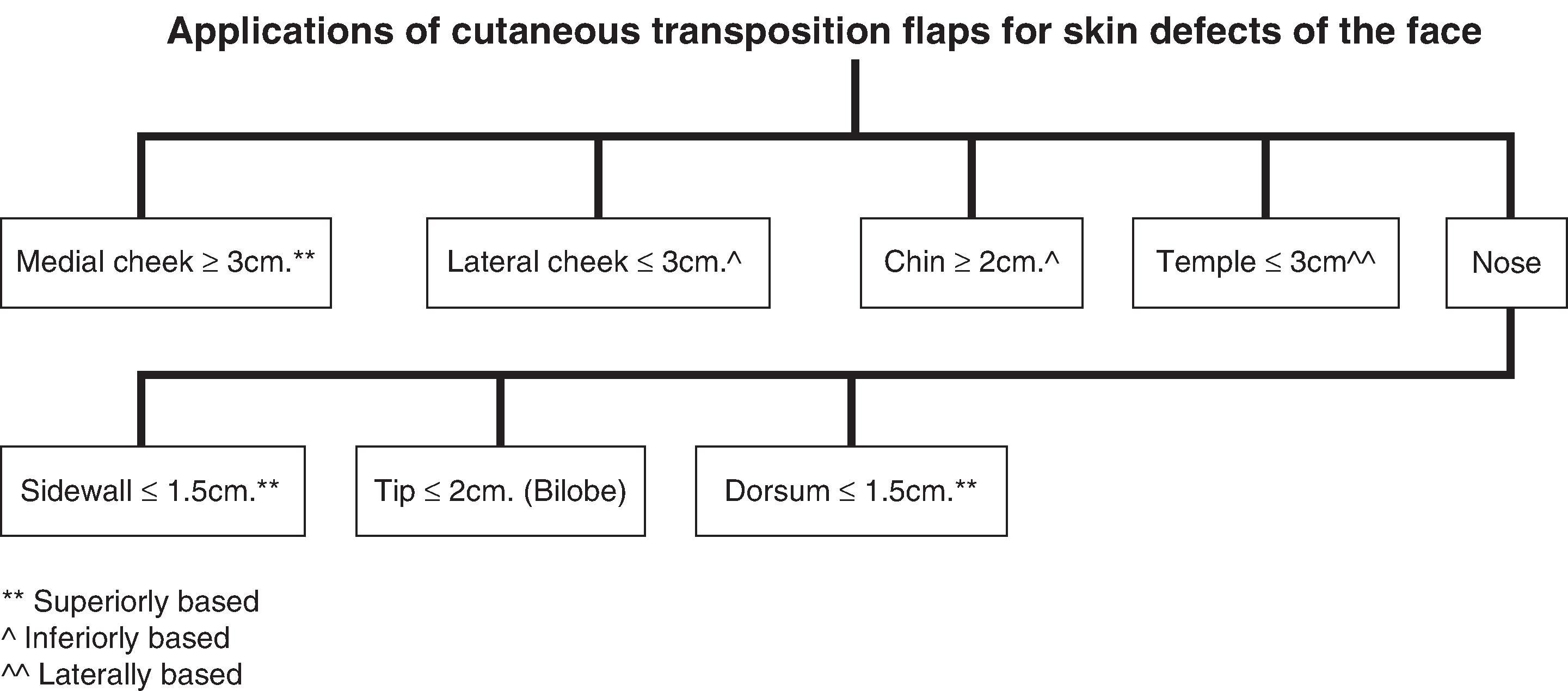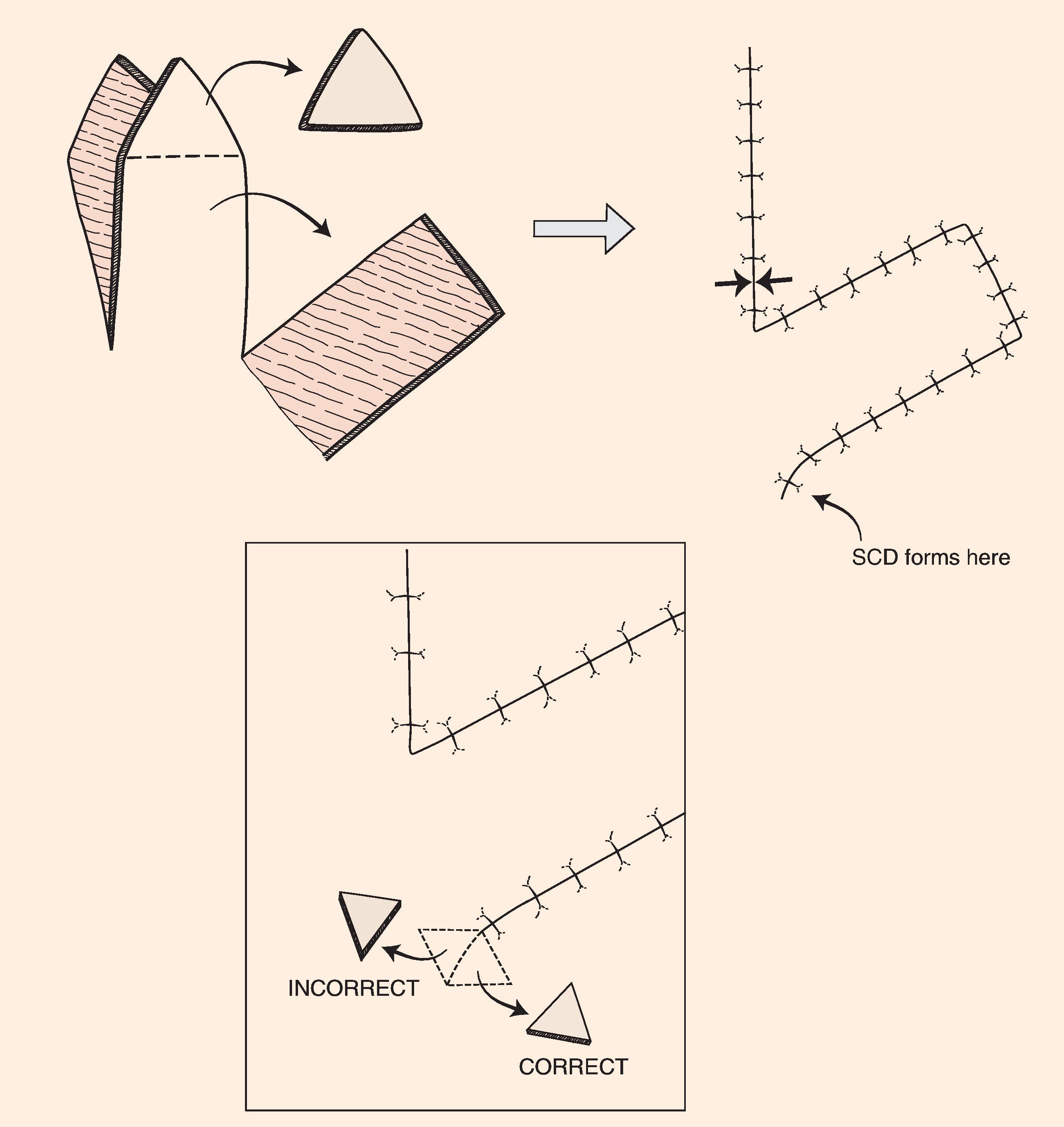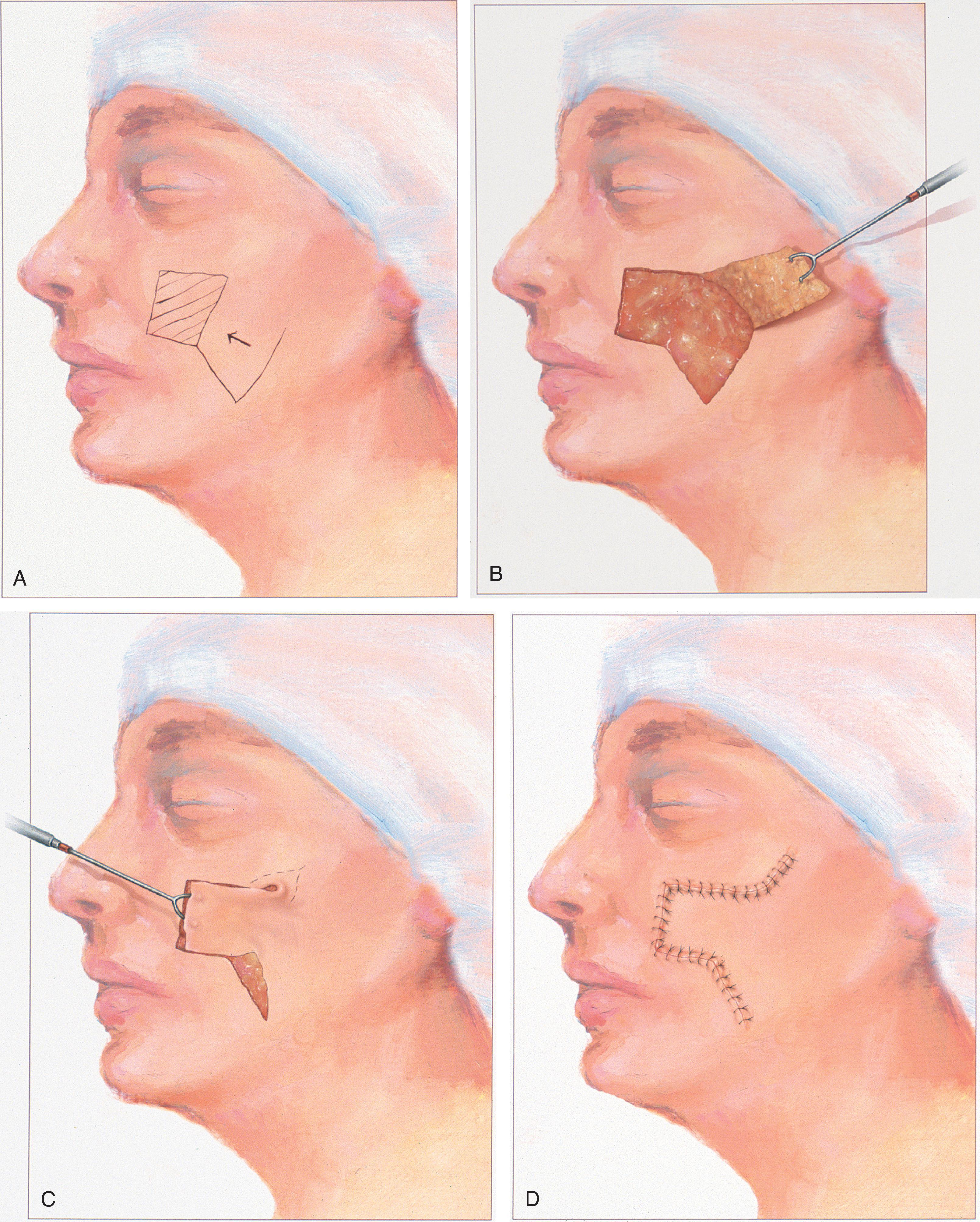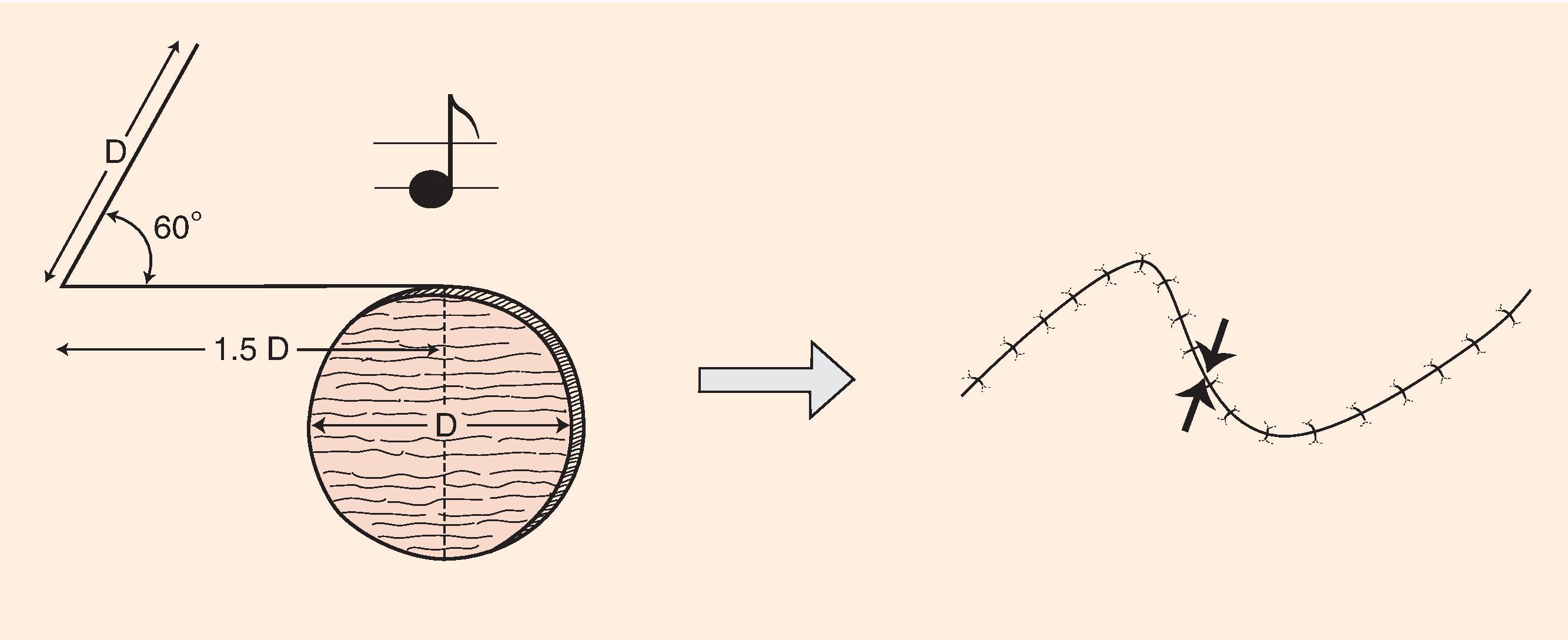Physical Address
304 North Cardinal St.
Dorchester Center, MA 02124
In contrast to rotation flaps, which have a curvilinear configuration, transposition flaps have a linear configuration. Both are pivotal flaps moving about a pivotal point. Both flaps develop standing cutaneous deformities (SCDs) at their bases and as a consequence, their effective length decreases as they pivot. This reduction in effective length must be considered when designing such flaps. Rotation flaps must be designed in such a manner that one border of the flap is also a border of the defect for which it is intended to repair. Like rotation flaps, transposition flaps may be designed so that one border of the flap is also a border of the defect; however, it may also be designed with borders that are removed from the defect. In this circumstance the base of the flap only is contiguous with the defect. The area of greatest wound closure tension is at the closure site of the secondary defect adjacent to the base of the flap. Depending on whether the flap is stretched and the degree of stretching, the greatest wound closure tension may be along a vector from the pivotal point to the most peripheral border of the flap. Transposition flaps are the most common flap design used to repair skin defects of the head and neck. They are designed in a multitude of sizes, shapes, and orientations. A transposition flap as a reconstructive option is applicable to almost any conceivable situation where a local flap is required to repair small-to-medium sized cutaneous defects of the face ( Fig. 8.1 ). This fact makes transposition flaps the most useful of local flaps in head and neck reconstruction.

Transposition flaps are usually designed as random cutaneous flaps but may occasionally be axial or compound. Although the majority of flaps on the face have a random blood supply, the abundant vascularity of the skin of the face and scalp often enables the successful transfer of flaps that exceed the 3:1 ratio of length to width. More important than such a ratio are the location and orientation of transposition flaps. For example, a superiorly or inferiorly based melolabial transposition flap can be successfully transferred with a length considerably longer than three times the width of the base. This is the result of orienting the linear axis of the flap directly above and parallel to the linear axis of the angular artery. Although the flap is rarely elevated as a true axial flap incorporating the angular artery, many small peripheral branches of the artery are probably included in the base of the melolabial flap. This accounts for its dependable vascularity when designed even as a lengthy flap.
Transposition flaps can be designed in a number of different configurations; however, their linear dimension is always longer than their width. Common configurations of transposition flaps are listed in Table 8.1 . The majority of facial cutaneous defects are repaired with transposition flaps designed as a rectangle, parabola, or rhombus. A rhombic flap and its modifications are transferred to the recipient site by advancement as well as pivoting. I discuss them here, however, because their major method of movement is pivotal, and like pure pivotal flaps, they develop a single SCD at their base. Z-plasty and bilobe flaps represent the use of two transposition flaps concomitantly. In the case of Z-plasty, diagonally opposing triangular-shaped flaps trade locations after transposition. A bilobe flap represents two transposition flaps designed on a common base. Nevertheless, each lobe has an independent pivotal point and each lobe develops an independent SCD.
|
|
|
|
|
|
|
|
|
|
|
|
|
There are a number of advantages of using transposition flaps. The greatest advantage is the ability to harvest a flap at some distance from the location of the defect. This advantage offers the surgeon the ability to use donor sites on the face with greater skin elasticity and redundancy. It also often allows placement of donor site scars in more advantageous locations, providing the best possible donor scar. Transposition flaps can be designed in a number of configurations to adapt to irregular-shaped defects. Ample quantities of subcutaneous fat may be left attached to the under surface of the flap and can be transferred with the cutaneous portion of the flap to assist with the filling of deep facial defects. Another advantage is that a lengthy flap relative to the width of the base can be developed and this facilitates closure of the donor defect without excessive wound closure tension. Specifically, the axes of the secondary defect of rectangular and parabolic-shaped flaps are linear, allowing them to be more easily closed. In addition, closure of donor sites for parabolic-shaped flaps usually does not require excision of an SCD.
Because transposition flaps are pivotal flaps, the greater the arc of pivotal movement, the greater will be the size of the standing cutaneous deformity and the less will be the effective length of the flap. Pivoting a transposition flap 45° from its in situ position reduces the effective length by 5%. A 90° pivot and 180° pivot reduce effective length by 15% and 40%, respectively (see discussion in Chapter 6 ). The reduction in effective length must be accounted for when designing transposition flaps so that greater pivoting requires a longer flap design. The most common error in using transposition flaps of any kind is to design the flap too short because of a poor understanding of this concept. As transposition flaps turn in an arc around their relatively fixed pivotal point, an SCD develops. Similar to the relationship between the arc of flap movement and effective length, there is a direct and positive association between the degree of pivoting and the size of the SCD. The greater the pivot of the flap, the larger the deformity that develops from the pivotal movement. Thus increasing the flap’s pivot will shorten the effective length, increase wound closure tension (if not designed sufficiently long), and change the flap’s shape as a result of forming an SCD at the base of the flap. To limit these restricting factors, transposition flaps should be designed not to pivot more than 90° whenever possible.
In the majority of cases, SCDs resulting from transposing flaps can be resected at the time of the initial flap transfer to the recipient site. Excision should always be in a vector that diverges from the base of the flap so vascularity is not unduly impaired ( Fig. 8.2 ). For the scalp and large transposition flaps of the face, it may be prudent to delay excision of the deformity for 4 to 6 weeks to allow revascularization of the distal flap.

A disadvantage of transposition flaps is the potential for developing a trap-door deformity. , The deformity is present when the flap appears bulky, protruding above the surface of the surrounding skin and giving the appearance of a pin cushion. This complication tends to occur a few weeks after transfer. A trap-door deformity occurs most often when curvilinear incisions are made at the distal border of flaps. Concentric contraction of the resulting scar presumably causes the curvilinear arc of the scar to contract toward its center, which in turn forces the skin to protrude outward above the surface of the surrounding skin. Creating straight rather than curved incisions and designing the distal border of the flap with an angle instead of an arc prevents curvilinear scars. Trap-door deformity may also develop because adjacent tissue surrounding the recipient site is not sufficiently undermined at the time of transposition. The sheet of scar that forms between the undersurface of the flap and the depth of the defect contracts in a concentric fashion. Contraction of the scar beneath the flap causes the flap to bulge outward. Fortunately, trap-door deformity usually resolves with time. Trap-door deformities can be minimized or prevented by wide subdermal undermining of the margins of the primary defect and using a flap with the same thickness as the depth of the recipient site. For defects located in skin with sebaceous gland hypertrophy, it is helpful to maintain the bevel of the defect resulting from micrographic surgery, or to create one, and to counter bevel the edge of the flap. This creates a diagonally sloping scar beneath the epidermis, which may reduce concentric scar contraction. As noted, concentric scars are a common cause of trap-door deformity.
When trap-door deformity does develop, it always occurs within the first 3 months postoperatively. The deformity can usually be treated medically by injecting 0.1 to 1cc (depending on the size of the flap) of triamcinolone acetonide (10mg/mL) into the area of the deformity and at the base of the flap. Injection should begin 4 weeks postoperatively and should be repeated 2 or 3 times at 6-week intervals. Injections should be placed deep in the subcutaneous fat, not immediately beneath the dermis. Superficial injection may cause atrophy or telangiectasias of the flap’s skin.
If after 8 months the deformity has not resolved, a frequently successful solution is scar revision. This is achieved by making an incision through a portion of the scar surrounding the flap, dissecting beneath the flap, and removing excessive subcutaneous fat and scar followed by wound closure. It is also beneficial to perform a Z-plasty in the area of the incision.
The rectangle or parabola-shaped transposition flap is commonly used for repair of cutaneous defects of the medial and lateral cheek, temple, and glabellar area ( Fig. 8.3 ). A linear closure of cutaneous defects of the temple often results in elevation of the lateral brow or webbing of the lateral canthus. The use of transposition flaps frequently can avoid these problems. Small flaps of this design can also be used to repair defects of the dorsum and sidewall of the nose, chin and upper and lower lips. Transferring skin or skin and muscle from the upper to the lower eyelid to repair anterior lamellar defects may readily be accomplished by using either medially or laterally based cutaneous or musculocutaneous (containing obicularis muscle) transposition flaps.

When transposition flaps are used to repair small (2 cm or less) cutaneous defects of the cheek they may be based superiorly or inferiorly. Transposition flaps used to repair defects greater than 3 cm should be superiorly based because there is more redundancy of facial skin in the inferior regions of the cheek. Transposition flaps used for repair of medial cheek defects are best designed so that the donor site is in the vicinity of the jowl. The jowl is the area of greatest facial skin redundancy. In older patients, this redundancy can provide a source for a large flap and still enable primary closure of the donor site. Superiorly based flaps maximize the use of skin in the area of the jowl. In such instances, flaps should be designed so that, whenever possible, closure of the donor site is in the melolabial and labiomandibular creases. The standing cutaneous deformity is removed just lateral to the superior border of the defect.
In the lateral cheek, transposition flaps are the preferred method of reconstructing small defects (less than 3 cm). Larger defects are best repaired with rotation advancement flaps designed to recruit upper cervical skin. Similar to the medial cheek, transposition flaps used for repair of lateral cheek defects should be based superiorly. Skin immediately above the angle of the mandible serves as the donor tissue for the flap. This is the preferred donor site because the inferior cheek skin has greater redundancy and mobility compared with skin located in the lateral superior cheek near the temple. The increased mobility is attributed to the presence of the platysmal muscle covering the mandible.
The vast majority of transposition flaps used on the face have a cutaneous pedicle and a random blood supply. Island transposition flaps based on an axial blood supply, however, can be harvested from the region of the forehead or medial cheek. In the forehead, the flap is transferred with the supratrochlear artery and vein. Such flaps have limited use for facial reconstruction but can be used to repair defects located on the upper nasal dorsum or medial canthus. Park and colleagues have shown that the superior labial artery gives rise to an artery to the nasal septum, which divides into a superficial and deep branch and a second independent artery to the nasal ala. The deep division of the septal artery can be used to nourish a sizeable mucosal island axial transposition flap harvested from the inner aspect of the upper lip. This flap can be used to reconstruct large defects of the vermilion. Similarly, sizeable island transposition flaps harvested with the skin and subcutaneous tissue of the upper melolabial fold can be transferred as an axial flap based on the alar artery, which arises from the facial artery just before the vessel gives rise to the superior labial artery. Common examples of island transposition flaps used in the head and scalp are flaps from the forehead transferred to the upper nose, temporal hair-bearing scalp flaps transferred to the anterior scalp to treat male pattern baldness, and palatal mucoperiosteal flaps transferred to the nasal surface of the velum.
The note flap described by Walike and Larrabee, Jr is an angular transposition flap that, when designed together with the defect, looks like a musical eighth note. This flap allows one to close a circular defect with a triangular-shaped transposition flap that maximizes the use of surrounding tissue ( Fig. 8.4 ). The flap is designed by first drawing a tangent on either side of the circle parallel to relaxed skin tension lines (RSTLs). The tangent should have the length of 1.5 times the diameter of the circular defect. At the end of the tangent line, a 50° to 60° angled flap is designed with the second side of the flap having a length approximately equal to the diameter of the circle. The flap is transposed into the defect and the distal tip of the flap is trimmed so that there is no wound closure tension. As with rectangular and parabolic-shaped transposition flaps, the greatest wound closure tension is at the closure of the donor site. In the case of the note flap, the greatest wound closure tension is approximately perpendicular to the tangent line created when designing the flap. The surface area of the note flap is designed so that it is 25% less than the area of the defect. Because the flap is smaller than the size of the defect, clinical judgment is required when using this flap. The flap is recommended primarily for small (2 cm or less) circular-shaped skin defects. Because the pivotal arc of the note flap is approximately 45°, a minimal SCD develops that may not require excision. SCDs of larger flaps will require subsequent surgical revision unless the deformities are removed at the time of flap transfer. I use the note flap primarily for defects on the cheek, temple, and lateral nasal sidewall. Nevertheless, it may be used everywhere on the head and neck including the lips.

Become a Clinical Tree membership for Full access and enjoy Unlimited articles
If you are a member. Log in here